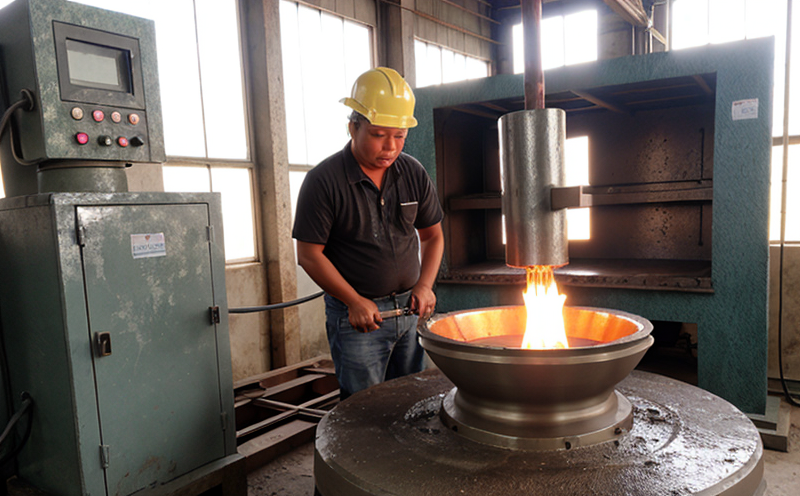ISO 8065 Casting Defect Classification Testing
The International Organization for Standardization (ISO) has developed a set of standards to ensure the quality and safety of castings used in various industrial applications. One such standard is ISO 8065, which provides guidelines for the classification of defects in castings. This service focuses on providing comprehensive testing according to ISO 8065, ensuring that our clients meet stringent industry standards.
The casting process involves transforming molten metal into a specific shape by using molds or dies. Despite advancements in technology and manufacturing techniques, imperfections can still occur during this process. These defects can range from minor surface irregularities to major structural weaknesses. Accurately identifying these defects is critical for ensuring the integrity and durability of castings used in industrial applications.
Our ISO 8065 Casting Defect Classification Testing service uses advanced non-destructive testing (NDT) methods such as ultrasonic, radiographic, magnetic particle, and liquid penetrant inspections. These techniques allow us to examine castings without damaging them, providing precise defect characterization. By adhering strictly to the procedures outlined in ISO 8065, we ensure that our clients receive accurate classifications of defects, facilitating informed decision-making regarding part acceptance or rejection.
One key aspect of this testing is the ability to classify defects according to their type and severity. Common types of defects include porosity, cracks, shrinkage cavities, and slag inclusions. Each defect has specific criteria for classification, which are detailed in ISO 8065. Our experienced technicians use specialized equipment and software to analyze these defects comprehensively.
Another critical component is the preparation of specimens prior to testing. Specimens must be representative of the entire batch or production run being tested. Proper cleaning, drying, and marking ensure that all defects are visible during inspection. Once prepared, specimens undergo rigorous examination using appropriate NDT methods tailored specifically for ISO 8065 compliance.
The results from our ISO 8065 Casting Defect Classification Testing service provide valuable insights into the quality of castings produced by manufacturers. This information helps companies improve their processes and maintain consistent product quality across batches or production runs. For customers who require certification or compliance with international standards, this service ensures they meet these requirements confidently.
Scope and Methodology
| Defect Type | Description | Acceptance Criteria |
|---|---|---|
| Porosity | Microscopic voids within the casting. | Permissible volume fractions must not exceed specified limits as per ISO 8065. |
| Cracks | Linear discontinuities in the metal matrix. | Crack lengths exceeding predefined thresholds are unacceptable. |
| Shrinkage Cavities | Regions where solidification has not fully occurred due to insufficient liquid metal. | Avoidance or control within acceptable limits as specified by ISO 8065. |
| Slag Inclusions | Inclusions of foreign materials from the sand mold. | Maximum permissible sizes and distributions are defined in ISO 8065. |
The testing process begins with thorough preparation of the casting specimen, ensuring it is clean and free from contaminants that could interfere with defect detection. Ultrasonic testing (UT) is often used for initial screening due to its ability to penetrate deep into materials and detect internal flaws non-destructively.
Following UT, radiographic inspection may be employed if further confirmation of specific defects like cracks or porosity is necessary. Magnetic particle testing can identify surface-breaking flaws on ferromagnetic metals, while liquid penetrant testing highlights subsurface discontinuities that are visible only under certain lighting conditions.
The data collected during these inspections is analyzed according to the guidelines set forth in ISO 8065. Defects are classified based on their type and extent of deviation from acceptable standards. A detailed report summarizing all findings, along with photographs or videos where applicable, accompanies each testing session.
Benefits
Adhering to ISO 8065 ensures that our clients produce castings that meet international quality standards. This not only enhances the reputation of manufacturers but also opens up new market opportunities domestically and internationally. By identifying defects early in the production cycle, potential issues can be addressed before they escalate into more serious problems.
Compliance with ISO 8065 helps companies avoid costly recalls and rejections by ensuring that all castings are thoroughly inspected and classified according to industry best practices. This proactive approach saves time and resources that would otherwise be spent rectifying defective products later in the supply chain.
In addition, this service supports continuous improvement efforts within manufacturing plants. By regularly assessing casting quality through rigorous testing processes aligned with ISO 8065, companies can pinpoint areas where process improvements are needed. Over time, these adjustments lead to enhanced overall production efficiency and reduced waste generation.
For procurement departments, knowing that suppliers adhere strictly to recognized international standards like ISO 8065 provides peace of mind regarding the reliability and consistency of purchased materials. It also allows for better negotiation of terms since buyers can confidently specify requirements based on established protocols rather than ad hoc agreements.
Customer Impact and Satisfaction
- Increased confidence in product quality through adherence to recognized international standards.
- Enhanced reputation among customers, partners, and stakeholders due to demonstrated commitment to excellence.
- Potential expansion into new markets where compliance with ISO 8065 is a prerequisite for entry.
- Reduced risk of non-compliance penalties by ensuring all testing aligns perfectly with regulatory requirements.
- Improved operational efficiency through early detection and correction of defects during the manufacturing process.
- Better negotiation leverage when sourcing materials or components from suppliers who already meet ISO 8065 criteria.
Our clients consistently report higher levels of satisfaction following our ISO 8065 Casting Defect Classification Testing service. They appreciate the detailed reports and actionable insights provided, which enable them to make informed decisions about their casting processes. Moreover, the peace of mind that comes from knowing every aspect of the testing process adheres strictly to international standards contributes significantly to client satisfaction.





